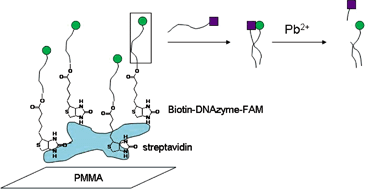Immobilization of DNAzyme catalytic beacons on PMMA for Pb2+ detection†
Abstract
Due to the numerous toxicological effects of lead, its presence in the environment needs to be effectively monitored. Incorporating a biosensing element within a microfluidic platform enables rapid and reliable determinations of lead at trace levels. A microchip-based lead sensor is described here that employs a lead-specific DNAzyme (also called catalytic DNA or deoxyribozyme) as a recognition element that cleaves its complementary substrate DNA strand only in the presence of cationic lead (Pb2+). Fluorescent tags on the DNAzyme translate the cleavage events to measurable, optical signals proportional to Pb2+ concentration. The DNAzyme responds sensitively and selectively to Pb2+, and immobilizing DNAzyme in the sensor permits both sensor regeneration and localization of the detection zone. Here, the DNAzyme has been immobilized on a PMMA surface using the highly specific


 Please wait while we load your content...
Please wait while we load your content...